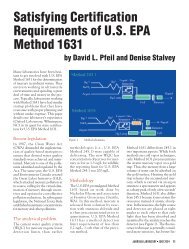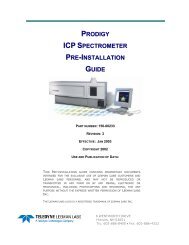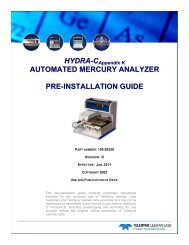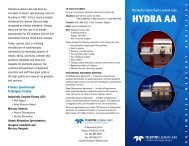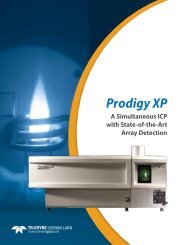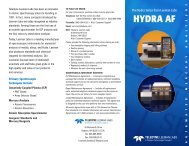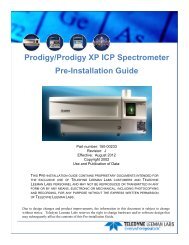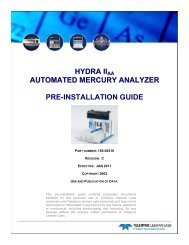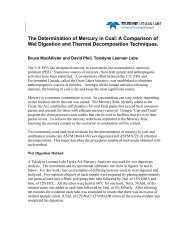Prodigy DC Arc - Teledyne Leeman Labs
Prodigy DC Arc - Teledyne Leeman Labs
Prodigy DC Arc - Teledyne Leeman Labs
Create successful ePaper yourself
Turn your PDF publications into a flip-book with our unique Google optimized e-Paper software.
<strong>Prodigy</strong> <strong>DC</strong> <strong>Arc</strong><br />
Garry Kunselman, Maura Mahar and Peter Brown<br />
<strong>Teledyne</strong> <strong>Leeman</strong> <strong>Labs</strong> 6 Wentworth Drive Hudson, NH 03051<br />
And<br />
Paul Dalager<br />
Analytical Reference Materials international<br />
www.leemanlabs.com
Why <strong>DC</strong> <strong>Arc</strong> <br />
The <strong>DC</strong> <strong>Arc</strong> Perspective<br />
Fast, quantitative multielement analysis of difficult to dissolve samples<br />
are hallmarks of the <strong>DC</strong> <strong>Arc</strong> approach.<br />
Few other techniques can challenge the ease-of-use or productivity of<br />
<strong>DC</strong> <strong>Arc</strong> for samples that are difficult or impossible to digest.<br />
AA, ICP and ICP - MS are powerful techniques but typically require<br />
the sample be put into the liquid form.<br />
• the digestion process always results in a large dilution of the<br />
analyte elements, problem for many apps<br />
• the digestion process does not eliminate the sample matrix, this<br />
is a problem for applications with matrix element<br />
spectral interferences<br />
www.leemanlabs.com
<strong>Prodigy</strong> <strong>DC</strong> <strong>Arc</strong> –state-of-the-art <strong>DC</strong> <strong>Arc</strong><br />
Fast, quantitative multielement analysis of difficult to dissolve<br />
samples are hallmarks of the <strong>DC</strong> <strong>Arc</strong> approach.<br />
Advantages Include:<br />
• Speed of analysis – typically about 1 minuet per sample<br />
• Great for difficult to dissolve samples<br />
• No sample digestion<br />
• ideal for ceramics, metal nitrides, metal carbides,<br />
• ideal for graphite<br />
• ideal for geological materials and soils<br />
• ideal for nuclear material (e.g. uranium oxide, plutonium oxide)<br />
• Favorable limits of detection (typically < 1ppm in the solid)<br />
• eliminates the sample dilution inherent in acid digestions<br />
• ideal for trace elements in high purity Cu<br />
• ideal for trace elements in precious metals<br />
<strong>Prodigy</strong> - The possibilities are limitless !
<strong>Prodigy</strong> <strong>DC</strong> <strong>Arc</strong> –state-of-the-art <strong>DC</strong> <strong>Arc</strong><br />
• The <strong>DC</strong> <strong>Arc</strong> Plasma Source<br />
– Sample deposited into electrode cup<br />
– High temperature <strong>DC</strong> Plasma struck between electrodes<br />
– Analyte is distilled away from matrix or consumed with it<br />
– Analyte signal is time dependent<br />
– Does not require argon or other gases for many applications
Brief History of <strong>DC</strong> <strong>Arc</strong> - photographic<br />
• Original Instruments were 3.4 m Photographic Plate Spectrometers<br />
• Captured the full spectrum photographically, but were cumbersome in<br />
terms of data handling – no computers<br />
• Photographic plates are no longer available
Brief History of <strong>DC</strong> <strong>Arc</strong> – PMT & CID<br />
AtomComp 2000<br />
Good instruments, but no<br />
longer built or supported.<br />
Stand alone aftermarket source with<br />
Fiber optic interface<br />
UV issues, worldwide support issues
Brief History of <strong>DC</strong> <strong>Arc</strong><br />
Historical <strong>DC</strong> <strong>Arc</strong> Sources<br />
• Awkward “jaw style” electrode clamps<br />
• Awkward “Stallwood” jet<br />
The “Spex” Stand<br />
The TJA Stand
Brief History of <strong>DC</strong> <strong>Arc</strong><br />
Historical Issues Associated with <strong>DC</strong> <strong>Arc</strong><br />
• Analysts that use them absolutely swear by them<br />
• “no other technique that provides what the <strong>DC</strong> <strong>Arc</strong> does”<br />
• Photographic plates are no longer available for the 3.4 m<br />
• Early <strong>Arc</strong> sources were a bit cumbersome and not automated<br />
• difficult “jaw style” electrode clamps<br />
• awkward “Stallwood” jets<br />
• no current control of the source<br />
• Limited market of 10 to 20 units per year led to limited investment in<br />
improvements of the technology or instrumentation
<strong>Prodigy</strong> <strong>DC</strong> <strong>Arc</strong> – state-of-the-art <strong>DC</strong> <strong>Arc</strong><br />
• Automated, compact, bench top <strong>DC</strong> <strong>Arc</strong><br />
• Ergonomically designed arc stand<br />
• Simple electrode changes<br />
• Built in “Stallwood Jet”<br />
• Improved precision<br />
•current controlled of the <strong>DC</strong> <strong>Arc</strong><br />
• Simultaneous background correction<br />
• Simultaneous internal standardization<br />
• Powerful full spectrum data capture<br />
• Provides qualitative and/or quantitative analysis<br />
• Allows spectral addition and subtraction
<strong>Prodigy</strong> <strong>DC</strong> <strong>Arc</strong> – state-of-the-art <strong>DC</strong> <strong>Arc</strong>
<strong>Prodigy</strong> <strong>DC</strong> <strong>Arc</strong> – state-of-the-art <strong>DC</strong> <strong>Arc</strong><br />
<strong>Prodigy</strong> <strong>DC</strong> <strong>Arc</strong>’s state-of-the-art <strong>DC</strong> <strong>Arc</strong> source<br />
• current control of the arc current<br />
• simple electrode changes<br />
• built-in “Stallwood Jet”
<strong>Prodigy</strong> <strong>DC</strong> <strong>Arc</strong> – state-of-the-art <strong>DC</strong> <strong>Arc</strong><br />
<strong>Prodigy</strong> <strong>DC</strong> <strong>Arc</strong>’s state-of-the-art <strong>DC</strong> <strong>Arc</strong> source
<strong>Prodigy</strong> <strong>DC</strong> <strong>Arc</strong> – state-of-the-art <strong>DC</strong> <strong>Arc</strong><br />
Ergonomic improvements to the <strong>DC</strong> <strong>Arc</strong> stand<br />
Access to The Counter Electrode<br />
• Counter electrode rotates out of the way so you do not have to “crank” it<br />
up and down for each sample<br />
• Simply rotate the electrode holder and change the electrode.
<strong>Prodigy</strong> <strong>DC</strong> <strong>Arc</strong> – state-of-the-art <strong>DC</strong> <strong>Arc</strong><br />
Ergonomic improvements to the <strong>DC</strong> <strong>Arc</strong> stand<br />
Sample Electrode Insertion<br />
• Counter electrode rotates out of the way<br />
• The new sample electrode and be inserted from the top or bottom of the<br />
electrode holder and as accurately positioned automatically.
<strong>Prodigy</strong> <strong>DC</strong> <strong>Arc</strong> – state-of-the-art <strong>DC</strong> <strong>Arc</strong><br />
Ergonomic improvements to the <strong>DC</strong> <strong>Arc</strong> stand<br />
Easily accommodates a wide range of sample electrodes<br />
• Mushroom electrode (for Cu analysis) shown with counter electrode<br />
slightly raised.
<strong>Prodigy</strong> <strong>DC</strong> <strong>Arc</strong> – state-of-the-art <strong>DC</strong> <strong>Arc</strong><br />
Fully Automated / Programmable control of source parameters<br />
• Independently programmable control of the arc current as<br />
well as argon and oxygen gases (when used)
<strong>Prodigy</strong> <strong>DC</strong> <strong>Arc</strong> – state-of-the-art <strong>DC</strong> <strong>Arc</strong><br />
Data collection versatility<br />
• Fast qualitative analysis for spectral fingerprinting<br />
• Time resolved analysis – for method development<br />
• Fast accurate quantitative analysis<br />
• The peak area can be placed anywhere in the subarray<br />
• peak area can be changed from 1 pixel to any number of pixels wide<br />
• The background points can be placed anywhere in the subarray<br />
• can be single or double sided<br />
• can contain multiple pixels
<strong>Prodigy</strong> <strong>DC</strong> <strong>Arc</strong> – state-of-the-art <strong>DC</strong> <strong>Arc</strong><br />
Advanced Calibration Capability<br />
• Fractional Exponent Quadratic<br />
• handles extreme curvature with improved accuracy ( in green)<br />
Note: simple<br />
quadratic curve<br />
fits poorly
<strong>Prodigy</strong> <strong>DC</strong> <strong>Arc</strong> – state-of-the-art <strong>DC</strong> <strong>Arc</strong><br />
Time Resolved Analysis scan of silicon carbide
<strong>Prodigy</strong> <strong>DC</strong> <strong>Arc</strong> – state-of-the-art <strong>DC</strong> <strong>Arc</strong><br />
Full Spectrum Acquisition of Ni<br />
• Note signal from wavelengths below Carbon 193.0
<strong>Prodigy</strong> <strong>DC</strong> <strong>Arc</strong> – state-of-the-art <strong>DC</strong> <strong>Arc</strong><br />
<strong>Prodigy</strong> <strong>DC</strong> <strong>Arc</strong> Provides:<br />
• Automated, compact, bench top <strong>DC</strong> <strong>Arc</strong><br />
• Ergonomically designed arc stand<br />
• Simple electrode changes<br />
• Built in “Stallwood Jet”<br />
• Improved precision<br />
•current controlled of the <strong>DC</strong> <strong>Arc</strong><br />
• Simultaneous background correction<br />
• Simultaneous internal standardization<br />
• Captures full spectrum<br />
• Provides qualitative and/or quantitative analysis<br />
• Allows spectral addition and subtraction




